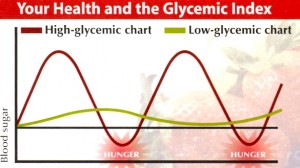Maintaining stable blood sugar levels is crucial for overall health and well-being. The glycemic index (GI) and glycemic load (GL) are valuable tools that can aid in achieving this goal. In this article, we will explore what the glycemic index is, how glycemic load is calculated, and the benefits of following a diet that limits the intake of high GI foods.
 But what exactly is the Glycemic Index?!
But what exactly is the Glycemic Index?!
The glycemic index is a ranking system that measures how quickly carbohydrates in food raise blood sugar levels. It assigns a numerical value to different foods, with glucose (the reference food) having a value of 100. Foods with a high GI (70 or above) cause a rapid spike in blood sugar, while those with a low GI (55 or below) have a slower and more gradual impact.
Calculating Glycemic Load
Although the glycemic index is useful, it doesn’t take into account the actual serving size of a food. This is where the glycemic load comes into play. The glycemic load incorporates both the GI and the amount of carbohydrates consumed in a serving. It provides a more accurate representation of a food’s impact on blood sugar levels.
Glycemic load is calculated using the following formula: Glycemic Load = (Glycemic Index × Net Carbohydrates) ÷ 100
The net carbohydrates in a food item refer to the total carbohydrates minus the fiber content. Foods with a glycemic load of 10 or below are considered low, while those above 20 are high.
Benefits of a Low-GI Diet
- Blood Sugar Control: One of the primary advantages of a low-GI diet is its positive impact on blood sugar control. High-GI foods cause a rapid increase in blood glucose levels, leading to corresponding insulin spikes. Consistently high blood sugar and insulin levels can contribute to insulin resistance and the development of type 2 diabetes. Research studies have shown that a low-GI diet can improve glycemic control, reducing the risk of diabetes and helping manage the condition in those already diagnosed.
- Weight Management: A low-GI diet can be an effective tool for weight management and the prevention of obesity. High-GI foods cause blood sugar spikes followed by crashes, which can trigger hunger and cravings for more high-GI foods. On the other hand, low-GI foods provide a sustained release of energy, promoting satiety and reducing the likelihood of overeating. Several studies have found that diets emphasizing low-GI foods can aid in weight loss and weight maintenance.
- Heart Health: Adopting a low-GI diet may have significant benefits for heart health. High-GI diets have been associated with an increased risk of heart disease due to their impact on blood sugar, insulin levels, and inflammation. Conversely, a low-GI diet can help reduce these risk factors. Research suggests that a low-GI diet can lower LDL cholesterol levels (the “bad” cholesterol), improve insulin sensitivity, and reduce markers of inflammation, all of which contribute to better cardiovascular health.
- Sustained Energy Levels: The slow and steady release of glucose from low-GI foods provides a steady supply of energy, supporting optimal physical and mental performance throughout the day. High-GI foods, by contrast, cause rapid energy spikes followed by crashes, leading to fatigue and decreased productivity. By choosing low-GI foods, individuals can maintain stable energy levels, enhance endurance, and improve cognitive function.
Getting Started on a Low-GI Diet
- Focus on Whole Foods: Emphasize whole, unprocessed foods such as fruits, vegetables, legumes, whole grains, lean proteins, and healthy fats. These foods generally have a lower GI and provide an array of essential nutrients.
- Opt for Low-GI Carbohydrates: Choose carbohydrates with a low GI, such as quinoa, barley, sweet potatoes, whole wheat bread, and most fruits and vegetables. These options offer a slower release of glucose, promoting stable blood sugar levels.
- Combine Foods: Combining carbohydrates with proteins or healthy fats can help lower the overall GI of a meal. For example, pair whole grain bread with avocado or have a mixed salad with chicken breast.
- Be Mindful of Portion Sizes: Although a low-GI diet is beneficial, portion control is still important for weight management. Keep an eye on overall calorie intake and consume carbohydrates in moderation.
- Experiment and Track: Every individual’s response to carbohydrates may vary. Experiment with different foods, note how they affect your blood sugar levels, and adjust accordingly. Regular monitoring of blood sugar levels can be helpful.
Low GI Foods
 The glycemic index and glycemic load provide valuable insights into the impact of carbohydrates on blood sugar levels. By following a low-GI diet, you can achieve better blood sugar control, promote weight management, support heart health, and sustain energy levels throughout the day. Incorporating whole foods, focusing on low-GI carbohydrates, and being mindful of portion sizes are effective strategies to get started on a low-GI diet. Consult with a healthcare professional or registered dietitian for personalized advice and support on your journey toward optimal health.
The glycemic index and glycemic load provide valuable insights into the impact of carbohydrates on blood sugar levels. By following a low-GI diet, you can achieve better blood sugar control, promote weight management, support heart health, and sustain energy levels throughout the day. Incorporating whole foods, focusing on low-GI carbohydrates, and being mindful of portion sizes are effective strategies to get started on a low-GI diet. Consult with a healthcare professional or registered dietitian for personalized advice and support on your journey toward optimal health.
References:
- Jenkins DJ, et al. Glycemic Index: Overview of Implications in Health and Disease. Am J Clin Nutr. 2002.
- Livesey G, et al. Glycemic Response and Health—A Systematic Review and Meta-Analysis: The Database Study of Individual Metabolic Responses to Glycemic Index. J Nutr. 2019.
- Brand-Miller J, et al. Glycemic Index, Glycemic Load, and Chronic Disease Risk—A Meta-Analysis of Observational Studies. Am J Clin Nutr. 2009.
- Ludwig DS, et al. High Glycemic Index Foods, Overeating, and Obesity. Pediatrics. 1999.
